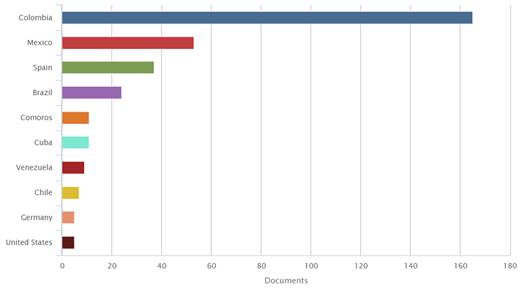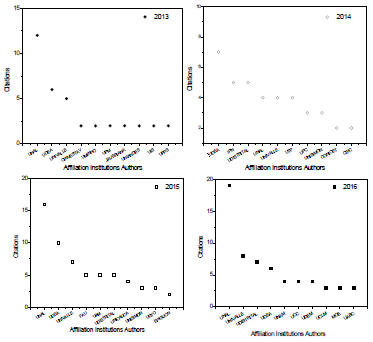In the present editorial, the analysis of the behavior of some bibliometric indicators of the Revista Facultad de Ingeniería Journal in the last years will be carried out. Adopting SCOPUS as a source, the Cite Score has been increasing from 0.08 to 0.31 (Figure 1 (a)), exhibiting a significant increase in the relation between the citations of the documents published in each of the related years and the number of documents published in the immediately preceding 3 years. The number of citations the journal has had over the last four years exhibits a parallel behavior (Figure 1 (b)) [1].
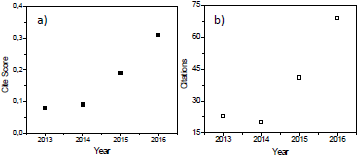
Figure 1 Behavior of a) Cite Score and b) citations for the Revista Facultad de Ingeniería in recent years
The SNIP (Source Normalized Impact per Paper) calculated for the Revista Facultad de Ingeniería shows an increase from 0.071 in 2014 to 0.355 in 2016 (Figure 2 (a)). This indicator lists the actual citations received with the citations expected within the thematic field [1]. The SJR (SCImago Journal Rank) takes the SCOPUS data and weighs the citations that each journal receives according to the SJR of the cited journal. The citations received from the journals with the highest SJR index are worth more than those received by those with the lowest SJR index [1, 2]. Figure 2 (b) shows the JRS behavior for the journal in the last four years.
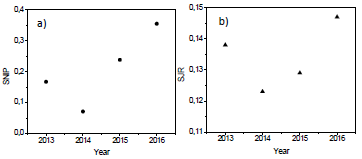
Figure 2 Behavior of bibliometric indicators for the Revista Facultad de Ingeniería a) SNIP and b) SJR
In the same period from 2013 -2016, the authors of the articles published in the Revista Facultad de Ingeniería Journal have institutional affiliation predominantly to Universidad de Antioquia and Universidad Nacional de Colombia, followed by the Politécnico Nacional de México and other national universities (Figure 3). From the first 10 institutions registered by SCOPUS, three are international institutions including the Universidad Politécnica de Madrid and the Universidad Autónoma Metropolitana de México [1]. However, these data should be carefully observed, according to Figure 3, it seems that authors of the Universidad de Antioquia published a high percentage of the articles of the journal, but this indicator also includes the editorials and letters to the editor. The journal in its editorial policies ensures that each published issue does not exceed 30% of authors of the same institution.
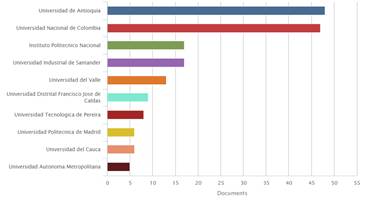
Figure 3 Distribution of the affiliated institutions of the authors publishing in the Revista Facultad de Ingeniería Journal
In the same period of 2013-2016, Figure 4 shows the distribution of the first ten countries of origin of the authors who publish in our journal. Colombia is the first country, followed by Mexico, Spain, Brazil, Comoros, Cuba, Venezuela, Chile, Germany and the United States.
Figure 5 shows the behavior of the international collaboration that is perceived in the articles published in the journal since 2009, taken from Scimago [3]. This decrease in international collaboration in recent years is interpreted as a consequence of the crisis occurring in the country with the noticeable and progressive cut of the budget for Science, Technology and Innovation. Lack of resources limits project development and collaboration with international peers.
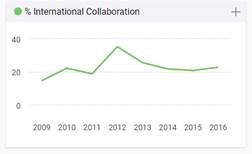
Figure 5 International collaboration reflected in the articles published in the Revista Facultad de Ingeniería
Using the option Citation Overview, available in SCOPUS, the first ten institutions of the authors citing the articles published in the Revista Facultad de Ingeniería, were separated by year of publication of the same articles (Figure 6). It can be observed that the authors of the Universidad Nacional de Colombia (UNAL-Colombia) have predominantly cited the articles of our journal published in 2013, 2015 and 2016. In 2014, the highest number of citations was by authors of Universidad de Antioquia (UDEA-Colombia). In addition to these universities, the Universidad del Valle (UNIVALLE-Colombia), el Centro de Investigación y de Estudios Avanzados del Instituto Politécnico Nacional (CINVESTAV-México), Universidade do Minho (UMINHO-Portugal), Universidad Politécnica de Madrid (UPM-España), Pontificia Universidad Javeriana (JAVERIANA-Colombia), Universidad de los Andes (UNIANDES-Colombia), Universidad Industrial de Santander (UIS-Colombia), Universidad Francisco de Paula Santander (UFPS-Colombia), Instituto Politécnico Nacional (IPN-Mexico), Universidad Distrital Francisco José de Caldas (UDISTRITAL-Colombia), Universidad Tecnológica de Pereira (UTP-Colombia), Universitat Politécnica de Catalunya (UPC-España), Universidad Simón Bolívar (UNISIMON-Venezuela), Consejo Nacional de Investigaciones Científicas y Técnicas (CONICET-Argentina), Consejo Superior de Investigaciones Científicas (CSIC-Spain), Friedrich-Alexander-Universität Erlangen-Nürberg (FAU-Germany), Universidad Autónoma Metropolitana (UAM-Mexico), Universidad del Cauca (UNICAUCA-Colombia), Universidad de Guanajuato (UGTO-Mexico), Escuela Politécnica de Ingeniería de Gijón (EPIGIJON-Spain), Universidad Nacional Autónoma de México (UNAM-México), Universidad Cooperativa de Colombia (UCC-Colombia), Universidad de Medellín (UDEM-Colombia), Universidad de Castilla La-Mancha (UCLM-Spain), Ministry of Education China (MOE-China) and the Universidad Autónoma de Baja California (UABC-Mexico).













